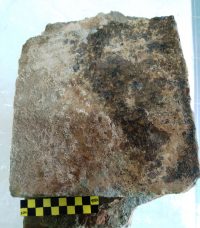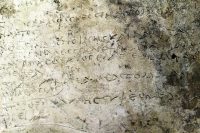 Archaeologists have discovered a clay tablet inscribed with verses from The Odyssey in Olympia, Greece. Found next to the Temple of Zeus with Roman-era artifacts, the slab is engraved with 13 verses from Odysseus’ speech to Eumaeus. Preliminary analysis suggests it dates to the Roman era, probably before the 3rd century.
Archaeologists have discovered a clay tablet inscribed with verses from The Odyssey in Olympia, Greece. Found next to the Temple of Zeus with Roman-era artifacts, the slab is engraved with 13 verses from Odysseus’ speech to Eumaeus. Preliminary analysis suggests it dates to the Roman era, probably before the 3rd century.
Olympia, the venue of the ancient Olympic Games, was a religious center from long before Homer was a twinkle in his mamma’s eye. There is archaeological evidence of burned offerings made at the site in the 4th millennium B.C. The first known temple was constructed in the early 7th century B.C. and was dedicated to Hera. Her husband overtook her in the mid-5th century B.C. when the Sanctuary of Zeus was built on a grander scale than any of the previous religious structures. The monumental gold and ivory statue of Zeus sculpted by Phidias (who had a workshop at Olympia) was one of the Seven Wonders of the Ancient World.
Olympia remained a cultural and religious beacon in the classical world even after it became part of the Roman Empire. Olympic games were still held and the faithful still flocked to the sanctuaries. It suffered from earthquakes and barbarian invasions in the 3rd century, but it wasn’t until the 5th century when it really came tumbling down. Literally. Eastern Roman Emperor Theodosius II ordered the Temple of Zeus destroyed in 426 A.D. and a series of earthquakes in the 6th century finished the job.
 The tablet was discovered during geoarchaeological survey of the site as part of the Multidimensional Space of Olympia program, a project which explores the relationships between the sanctuary and surrounding areas. During three years of fieldwork (2015-2017), a multidisciplinary team of researchers did an intensive grid survey of ancient Olympia, its immediate surroundings and the nearby villages of Epitalio and Salmone. They made several important discoveries in the process — Mycenaean chamber graves, Bronze Age terracing, the remains of an ancient polygonal wall and one very special clay tablet.
The tablet was discovered during geoarchaeological survey of the site as part of the Multidimensional Space of Olympia program, a project which explores the relationships between the sanctuary and surrounding areas. During three years of fieldwork (2015-2017), a multidisciplinary team of researchers did an intensive grid survey of ancient Olympia, its immediate surroundings and the nearby villages of Epitalio and Salmone. They made several important discoveries in the process — Mycenaean chamber graves, Bronze Age terracing, the remains of an ancient polygonal wall and one very special clay tablet.
The tablet’s likely age places it at the end of Olympia’s long history of Panhellenic prominence. It’s of enormous significance because even at so late a date it is likely the oldest written extract of the Homeric epic known to survive. It is now undergoing conservation and detailed epigraphic study which will confirm or deny the preliminary dating and hopefully narrow it down further.
Yes, in the linked article it reads “μπορεί να χρονολογηθεί στη ρωμαϊκή εποχή και πιθανώς πριν από τον 3ο αι. μ.Χ.”, i.e. possibly dated to Roman times and probably before the 3rd century (AD), as mentioned, ‘at the end of Olympia’s long history’.
Contrastingly, a much more detailed -and really massive- ‘slab’ inscription from the early 5th century BC, is the ‘Gortyn code’ (also referred to as the ‘Great Code’), to be seen in Gortyn in southern Crete. By the way, near Phaistos, where -according to Homer- errant Odysseus was sailing by (in a storm, if I remember correctly.
Gortyn itself is mentioned in Homer’s “Ilias”, where in Bk 2, beginning at line 645, it reads:
—————
“And the Cretans had as leader Idomeneus, famed for his spear, even they that held Knossos and Gortyn, famed for its walls, Lyctus and Miletus and Lycastus, white with chalk, and Phaistos and Rhytium, well-peopled cities; and all they beside that dwelt in Crete of the hundred cities. Of all these was Idomeneus, famed for his spear, captain, and Meriones, the peer of Enyalius, slayer of men. And with these there followed eighty black ships.”
:hattip:
Artful lines not very artfully drawn. Looks like it was done by someone with a sharp stick.
CW,
That’s interesting. Yes, some ancients don’t seem to have had the sense of symmetry and rectilinearity that we expect. You should see some of the older Phoenician writings.
Yet Roman engravings of that time period don’t typically look like this. That does have me wondering whether it might be older, or perhaps in a backward-looking style, possibly modeled on some older plaque at the shrine in Olympia.
Frankly, and having read that the slab is made of -once presumably fresh- clay, the explanation might be simpler:
While nowadays people sometimes go to, what they refer to as “gym”, the ancients went to a “gymnasion”, a training facility for competitors in public games and –last but not least– a place for socializing and engaging in intellectual pursuits – i.e. scribbling down Homeric verses in wet clay, for example.
Apparently (“γυμνός”), the did all this naked :boogie: !!!
—-
PS: The ‘Gortyn Code’ was not scribbled, but having read that part also, Homer was not talking about Odysseus himself in his 3rd hymn.
even at so late a date it is likely the oldest written extract of the Homeric epic known to survive.
What’s this then? And these?
The Guardian quotes the culture ministry as saying that it, “could be the oldest written record of Homer’s work ever discovered in Greece” [emphasis added], which is an entirely different thing.